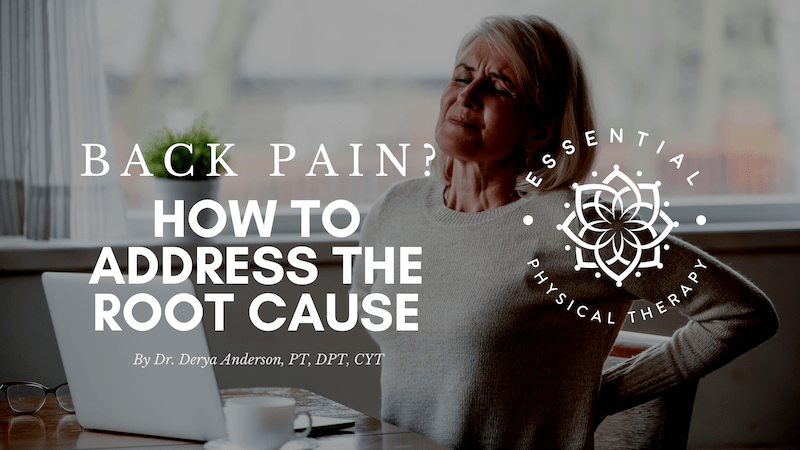Almost everyone will struggle with back pain at some point in their lives. For some it comes and goes, for others it’s a once in a while thing, and for others it becomes a part of their lives.
What’s even more concerning is that the outcomes for surgery for back pain are not that great. Several studies have shown that long term results for patients who had surgery for their back pain were the same as those who were treated with exercise and cognitive therapy.
Why doesn’t surgery work?
Our spines are complex, we humans are complex! The thinking that the source of the pain is always at the location of the pain is almost always wrong unless you had a direct trauma to that area.
This is because we compensate, and we do it really darn well.
Have you ever had to wear a cast or boot after spraining (or breaking) your ankle or your foot? Maybe you even had to use crutches. Soon, your arms, neck, and hips and probably some other body parts will start to hurt. (Don’t worry, I’ll get back to the back pain soon, stick with me here!)
But there was no direct injury to anything except your ankle! The pain in those other areas occur because you are compensating for not being able to use your foot properly.
The problem is, we all have histories of injuries that make us compensate slightly, and underlying all of that we have an asymmetrical brain and an asymmetrical body that will make us prefer to do things differently on one side than the other.
That’s not really a problem if you’re a wild human foraging for berries or climbing trees all day. But if you’re a modern human, you’re forced into positions (sitting at your desk or your car) and actions (writing, typing, opening doors) that your body will do over and over and over again on the same side.
This creates asymmetries that become ingrained, and now we have to compensate somehow.
So what does this have to do with back pain?
The Postural Restoration Institute, or PRI, clarifies how these asymmetries affect us and can cause problems. Here is a brief synopsis of why and how our asymmetrical nature impacts our lives…
We have a more stable, domed, strong diaphragm on the right accompanied by a flatter, weaker diaphragm on the left. this makes us feel much more comfortable standing over our right leg.
This orients our pelvis slightly to the right.
But nobody walks around with their body pointed to the right! No, we compensate to bring our chest back around to the left, so we can see where we’re going.
So, basically, our pelvis is pointing right, while our ribcage is pointing left. With walking and other alternating activities, we alternate by turning our pelvis to the left and ribcage to the right, but because of the strong anatomical tendencies listed above, we can lose this ability to alternate symmetrically.
Over time, or with repetitive activity, or injuries, we can become “stuck” in this twist. Some degenerative changes can occur, but the research unequivocally shows that disc degeneration or arthritis is usually NOT the cause of back pain (in studies where they scanned hundreds of people, some with back pain and some without, there was no correlation with back pain and arthritis/disc disease or other imaging findings. In fact, some people had severe pain and no findings on imaging, while others had severe degeneration, arthritis, and bulging discs, but no pain)!
The key to getting out of back pain for good is not going under the knife, but rather learning how to bring your pelvis back around to the left, and your trunk back around to the right.
To do so, breathing must become re-organized and re-balanced (remember that the diaphragm is the start of all this asymmetry!) and new movement patterns need to be established.
One very simple thing you can do to start training your body out of compensation is working on getting your left lower ribs down, in, and back. This will promote doming of the left diaphragm and bring your trunk back to a neutral position over your pelvis.
Here’s how to start re-orienting your ribcage to untwist your spine:
References:
Weber H. Lumbar disc herniation. A controlled, prospective study with ten years of observation. Spine (Phila Pa 1976). 1983;8(2):131.
Chou R, Baisden J, Carragee EJ, Resnick DK, Shaffer WO, Loeser JD. Surgery for low back pain: a review of the evidence for an American Pain Society Clinical Practice Guideline. Spine (Phila Pa 1976). 2009;34(10):1094-1109. doi:10.1097/BRS.0b013e3181a105fc
Brox JI, Nygaard ØP, Holm I, Keller A, Ingebrigtsen T, Reikerås O. Four-year follow-up of surgical versus non-surgical therapy for chronic low back pain. Ann Rheum Dis. 2010;69(9):1643-1648. doi:10.1136/ard.2009.108902
Rao D, Scuderi G, Scuderi C, Grewal R, Sandhu SJ. The Use of Imaging in Management of Patients with Low Back Pain. J Clin Imaging Sci. 2018;8:30. Published 2018 Aug 24. doi:10.4103/jcis.JCIS_16_18
Wáng YXJ, Wu AM, Ruiz Santiago F, Nogueira-Barbosa MH. Informed appropriate imaging for low back pain management: A narrative review. J Orthop Translat. 2018;15:21-34. Published 2018 Aug 27. doi:10.1016/j.jot.2018.07.009
Lateef H, Patel D. What is the role of imaging in acute low back pain?. Curr Rev Musculoskelet Med. 2009;2(2):69-73. doi:10.1007/s12178-008-9037-0






